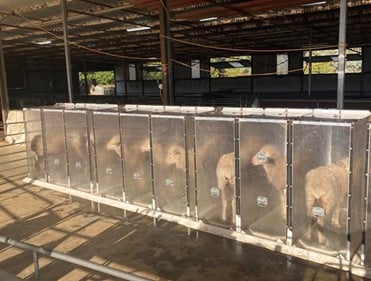Selecting for more methane efficient sheep



Expression of Interest: Terms of Reference
Emissions Avoidance Partnership (EAP) – Selecting for more methane efficient sheep
Date: 26th August 2023
MLA Program: Emissions Avoidance Program
Project Leader: Julius van der Werf sheepmethane@une.edu.au
- Purpose and background:
Meat & Livestock Australia (MLA) with The University of New England and the NSW Department of Primary Industries are co-funding the project “Selecting for lower methane sheep” through the Emissions Avoidance Partnership (EAP). The overall objective of the project is to enable Australian sheep breeders to select for reduced enteric methane emission. The project aims to collect methane data on 10,000 sheep across the sheep industry.
We are seeking breeders to collaborate with to enable us to collect measures of methane production from industry animals.
The data will be used to obtain accurate estimates of genetic variation and heritability of methane emission traits and their correlations with other economic traits in sheep production, including feed intake. We will develop and propose a strategy for breeders to genetically improve sheep for low emission traits, whilst also selecting for productivity.
- Objective
We are currently seeking expressions of interest (EOI) from Merino and Maternal breeders willing to have their breeding ewes measured for methane output using portable accumulation chambers (PACs), with approximately 80:20 split between Merinos and Maternal animals in the project. Ewes will be kept in the chamber for 40 minutes, after an hour off feed and possibly several hours with limited feed intake. Twelve ewes can be measured at a time in one run, and typically we will aim to measure 5 -6 runs per day, i.e. we measure 60-72 animals per day.
Methane measurement will be at no cost to the breeder, but the project will maintain ownership of the data. Ewes will be measured after weaning up until the very early stages of pregnancy. Sheep will also have rumen samples taken for the purpose of microbiome and volatile fatty acid profile recording to better understand variation in methane (CH4) emission.

- Criteria for involvement
Individual breeders and/or breeder groups are invited to submit an EOI if they meet the following requirements and information recorded on-farm:
- Ewes should be Merino or maternal breeds and from sires that are well represented across the industry; Preference will be given to ensure an 80:20 split between merinos and maternal breeds
- A minimum of 250 mixed age ewes with maximum age of ewes 5 y.o.; preference will be given to applications with greater numbers of ewes, however a maximum number of 500 ewes will be measured
- A minimum of 13 sires represented within each cohort and no more than 20 progeny per sire. Preference will be given to cohorts with more animals and sires represented
- Genotype data on a 50k array submitted (the project can assist with some genotyping but preference will be given to breeders that already genotype their ewes);
- These ewes should have had, or soon have, additional phenotypic measurement on other important breeding objective traits. The data already, or to be, submitted to Sheep Genetics, must include:
- Reproductive data including conception, litter size and ewe rearing ability
- Lifetime data including various weights (WWT, PWT, YWT, AWT)
- Wool production data (FW, FD)
Ewes will need to be weighed by the producer within one week prior to measurement through the PAC. We require an undercover work area with power, water and good livestock handling facilities. Producers will need to deliver each day’s sheep (up to 72 head) to a paddock or holding yard containing water and feed (ideally pasture), adjacent to handling facilities. Sheep will need to be taken off-feed in groups of 12 one hour before methane measurement.
- Confidentiality and Intellectual property (IP)
The source of data will be acknowledged in reports to MLA. Any data/information collected under the project will be owned and managed by MLA and may be used for research and development by MLA, and used in ‘Breeding Values Services’ and any ‘National Genetics Data Platforms’, defined as below. The data collected by the breeder on other traits as well as their genotype data will remain in ownership of the breeder, but the breeder will allow the project to use that data for the purpose of the project
Breeding Values Services means any service which involves estimation of genetic or genomic breeding values for cattle, goat and sheep, including without limitation the service offered which uses the analytical software currently known as BREEDPLAN and OVIS software.
National Genetics Data Platform means database or network of databases and analytics infrastructure established to store, process and enable access to, in accordance with defined IP rights, data, IP, products and tools relevant to livestock genetics.
Ethics approval
The project has been approved by the University of New England’s Animal Ethics Committee under AUTHORITY No: ARA21-086
- Submissions
Breeders and/or breeder groups should submit the Expression of Interest Template to sheepmethane@une.edu.au by COB 23rd October 2023.
Applicants will be advised in writing of the outcome of their expression of interest by mid November 2023 with preliminary approval granted to successful applicants. Successful applicants will work with the Project Team to finalise the details of measurement.
Further information
For any enquiries about your eligibility or for further details on the EOI, please email sheepmethane@une.edu.au